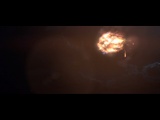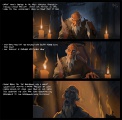The Meteor
The mystical meteor seen in the WWI 2008 intro cinematic is obviously important to Diablo 3's story line, but the purpose of it, or what it is, remains unknown.
- See Meteor for the Wizard skill.
Contents
MeteorEdit

We know from the cinematic and other art that Leah and Deckard Cain were at the cathedral at the time the meteor struck, crashing through many levels down into the catacombs below. Exactly who is where when the meteor hits is unknown, but further explained in the Cain and Leah section below.
Blizzard has said the catacombs we see here are essentially the same ones we visited in Diablo I, where Diablo himself was once "defeated".
In the BlizzCon 2008 playable demo, Captain Rumford says a meteor had struck the cathedral and it has awakened evil within. He asks you to investigate. This awakened evil turns out to be King Leoric (or possibly something deep underneath, where the demo characters were not able to proceed to). Whether we'll see the same story in the full game is unknown.
Cinematic Meteor EventEdit
This is the sequence in which the cinematic movie from WWI 2008 depicts the meteor:
New Tristram Cathedral.
Impacts in Tristram Cathedral.
Diablo behind it?
SpeculationEdit
What the meteor actually contains is unknown. The only things fans have been able to speculate about are information given in the concept art.
It is of course possible the flaming stone is just some spirit from above that resurrects Leoric, but knowing Blizzard's intricate story lines, it's likely something much greater than just the Skeleton King.
Fallen AngelEdit
One theory is that the comet is in fact an Angel who has been expelled from the High Heavens for unknown reasons, and that such an angel may have impacted or been made to impact Tristram Cathedral as a sign, perhaps to draw heroes there. This theory may be supported by concept art, which may show the meteor with an angel-like appearance. Tyrael and Izual are two popular candidates, who may have been banished by the Angiris Council for too often interfering with the Sanctuary.
Below are concept art pieces that have been speculated to be related:
Was Cain originally supposed to be in the Cathedral, or was he just not visible in the cinematic?
Meteor impacts, but does not hurt Leah.
Presumably Leah looks down the crater.
Some Angel-type entity doing something involving fireing up his wings...
Tyrael on Diablo3.com changed wing-look on Dec 10 2008, is this related to the left image?
Looks a lot like the previous Angel in the tower, has a helmet with horns/wings, and apparently turns to fire/light. Tyrael has no such helmet normally.
Cain and LeahEdit
Exactly how things progressed at the impact is not known yet. There is a lot of concept art about Leah and Cain in and around Tristram Cathedral, and through any game or story development things change. Not all of these images are necessarily part of the actual story we'll experience in Diablo III
In the material we do have access to, it does seems like Deckard Cain is sitting furthest in to the Cathedral, noticing the light from the meteor shortly before impact, and Leah running in to try and save him. Either he is hit, somehow not killed and pushed into the labyrinth below, or neither of them are hit.
Only Leah is seen approaching the big gaping hole, looking down. However, the similar scene from the cinematic shows only the hole, and no Leah looking down.
We know Cain has spent the last 20 years trying to find out why there has not been a demonic onslaught after the Worldstone was destroyed, and either all that research has been done in Tristram Cathedral, or they just recently arrived there.
From Abd al-Hazir's entry about Gnarled Walkers, we know Wortham is close to Tristram, and at one point, Leah was there with her father. This could have been either before she met up with Cain or a brief trip to Wortham with her father during the research.
We do know Cain and Leah know of and care for each other, as the WWI 2008 gameplay video has the Barbarian telling Cain that Leah is worried about him. Since he is alive and down in the labyrinth (which you get to by jumping down the hole), either he wasn't hit, or the meteor isn't a meteor in the common sense. The meteor could simply be one of the aforementioned Angels (Tyrael or Izual), who makes sure to save Cain on the way down, saving him from the impact that destroys the Cathedral.
Exactly how he got down there, and is looking through old scriptures there is unknown, and this could also be a story interaction that will be cut from the actual game. If this has any significance or not is also unknown.
If nothing else, the two of them are both obviously surprised when the meteor comes rushing down, so it did indeed appear unexpectedly.
Beyond SpeculationEdit
There has been a large amount of datamining of the beta game files, and it is generally known what the precise nature of the meteor is. In the beta test, the Cathedral features a large, gaping chasm that runs through the entire structure, on multiple levels. The hole is blue in color, with what looks like liquid fire running down the sides.
Blizzard released a screenshot of what is at the bottom of the hole, in an image entitled Wizard and Templar Meet a Stranger, which can be seen below. It is hidden behind a link to prevent spoilers:
MediaEdit
You can find pictures in the Diablo 3 screenshot and picture gallery:
Meteor TermsEdit
A meteoroid is a sand- to boulder-sized particle of debris in the Solar System. [1] The visible path of a meteoroid that enters Earth's (or another body's) atmosphere is called a meteor, or colloquially a shooting star or falling star. The term "meteorite" refers to the source of light, while the term "meteor" refers to what is generally seen in the sky by the human eye. If a meteor reaches the ground and survives impact, then it is called a meteoroid [2] or, depending upon circumstance and elemental composition, a chondrite [3]. Many meteors appearing seconds or minutes apart are called a meteor shower. The root word meteor comes from the Greek meteōros, meaning "high in the air".
Furthermore, the color of the meteroid's trail when it is entering the atmosphere is determined by the atomic composition of gasses surrounding the rock. Different atoms will burn at a different color in the light spectrum, but meteoroids often burn white due to a varied composition.
ReferenceEdit
- Diablo III Cinematic Trailer
- Blizzcon 2008 Hands-on Playable Demo
- Captain Rumford Quest















